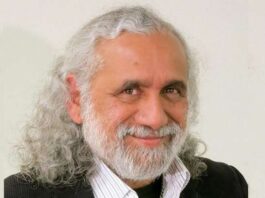
Troubled by the mundane colorful shades of life in the 21st century, we may find solace by indulging ourselves in the black and white shades of the 60s. Grabbing a cup of tea, sitting in a dim lighted surrounding and playing a 60s film can be a refreshing break from the hustle and bustle of weary life whereas the melancholic and exuberant songs of the 60s can cast a long-lasting impact as it turned out to be the case for me while watching Asli-Naqli (1962). However, the film entails much more than mere being esthetically pleasing.
Asli-Naqli 1962 (Real-Fake)—a classical 60s Hindi film written by Inder Raj Anand featuring the sensational Dev Anand as a leading actor—is an engrossing story of a carefree billionaire whose life takes turn when he decides to leave his Grandfather’s luxurious villa for establishing an identity of his own following an argument with him. In this way, desolated, estranged and homeless Anand ends up living with Mohan—a necessitous factory worker—and his sister Shanti as Mohan generously and wholeheartedly offers him food and shelter.
The film profoundly insinuates the dehumanizing rhetoric of materialism and unveils the ugly side of western modernity in the context of post-colonial India. It showcases life as lived by the folks in two contrasting segments of society; ergo entwining together, the film artistically explores two divergent lifestyles. On the one hand, it captures a modernized posh community—the likes of Anand and his Grandfather. On the other hand, it depicts the destitute conditions of bustee epitomized by Mohan, Mohan’s sister Shanti, Renu, and other proximate characters.
Such a juxtaposition makes one chew over the obnoxious ramification of western modernity in terms of impoverishing the standards of living, and the harms of materialism in alienating and dehumanizing human beings. For instance, in a jolting dialogue exchange at the start of the film, Colonel Mishra points out the emptiness of Anand’s life as “Your wealth has impoverished you. It has alienated you. To avoid things, you keep going around your own circle. You don’t try to recognize the true life. You cheat on life so life deceives you.” When such apprehension is viewed against the distinctive lives of the inhabitants of bustee, it invites speculation. It makes one ruminate about the real nature of impoverishment by accentuating that where Mohan—who serves as a voice and experience of the marginalized people—is impoverished in his lacking the material wealth, ironically Anand is impoverished for his lack of meaningful connection in his life which he can’t find in his material wealth or from the hypocritic people-pleasers around him.
A sharp comparison between the two worlds—modernized and destitute—has also been depicted, in the film, with regards to their individualistic and collective approach towards life. Well off Anand, at the start of the film, stands as a classic example of a fragmented, alienated, and disoriented individual which is a product of western modernity. Although luxuriously untrammeled yet Anand used to live an awfully lonely life at his Grandfather’s villa. Thus, being an independent individual as is championed by modernity, he feels isolated rather than feeling empowered. However, Mohan, Shanti, Renu, and others, living in dire poverty form an intertwined solid and tough community where sorrows, poverty, joy, and success of one is shared by them all collectively. It is the collectivity that enables them to challenge the materialistic outlook of life as perceived by Anand’s Grandfather towards the end of the film.
Grandfather holds a materialistic view of the world whereby he pressurizes Anand to marry the daughter of a rich factory owner in order to enhance his business. Later on, in the film, Anand falls in love with a girl named Renu who comes to teach the people of bustee. Anand explores the humanitarian aspect of culture in his attempt to make an identity of his own. He towards the end of the film identifies himself with the people of the bustee preferring humanitarianism over the dehumanizing materialistic lifestyle.
Throughout, leaving unto the viewers to decide the film poses a perpetual rhetorical question that what is Asli(Real) life and what is Naqli(Fake) life while evidently pointing the superficiality and fakeness of the materialistic modern life. Along these lines, it, therefore, encapsulates the struggle of an individual in the pursuit of a better outlook of life. Anand is the one who has to decide between Asli and Naqli (Real and Fake) for which he took a conscious decision to search for a purposeful life at the very beginning of the film. He lived and experienced both lives, and chose for himself the real-life—the one based on caring about and uplifting others, instead of the self-serving materialistic modern life. This suggests that real life lies beyond the pleasing lies told by materialistic western modernity.
Alongside enjoyment and entertainment, It is therefore binding on us as well to analyze and make a conscious decision about living a purposeful life. As Socrates puts it, “An unexamined life isn’t worth living.” This isn’t to suggest that we start living in shantytowns rather it is about urging one to become aware of the dangers of the pretentious slogans of modernity, materialism, and commodification.





